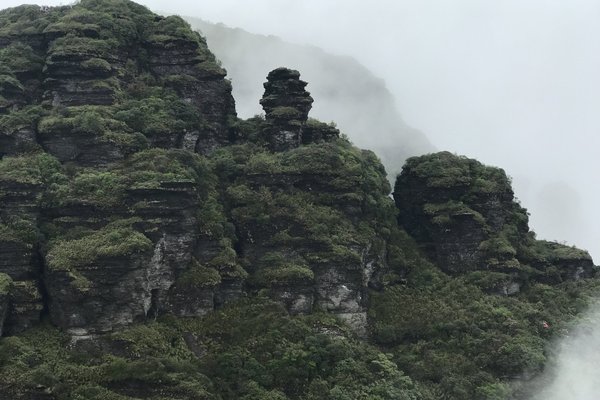China
Fanjingshan
Fanjingshan is an isolated mountain landscape with a high degree of endemism.
The property’s geologic and climatic characteristics have shaped its flora which behaves as if it were on an island. The rugged terrain of primary forest contains many endangered floral and fauna species, such as the Guizhou snub-nosed monkey. Fanjingshan’s wet conditions also result in an extraordinary richness of bryophytes (mosses).
Community Perspective: Zoë definitely recommends a visit and has written a comprehensive review about what to expect (spoiler alert: you’re unlikely to encounter an endangered Guizhou monkey).
Site Info
Official Information
- Full Name
- Fanjingshan (ID: 1559)
- Country
- China
- Status
-
Inscribed 2018
Site history
History of Fanjingshan
- 2018: Advisory Body overruled
- IUCN advised a Referral
- 2018: Inscribed
- Inscribed
- Type
- Natural
- Criteria
- x
Links
- UNESCO
- whc.unesco.org
All Links
UNESCO.org
- whc.unesco.org — whc.unesco.org/
News Article
- July 31, 2023 globaltimes.cn — Five staff under investigation for painting world heritage site in SW China pink
- Dec. 20, 2019 news.cgtn.com — Big data assists tourism at China's world heritage site
- July 14, 2018 xinhuanet.com — China's newest world heritage site limits visitor numbers
Community Information
- Community Category
- Natural landscape: Mountain
Travel Information
Recent Connections
-
Centres of Plant Diversity
EA16 Fanjing Mountains - "A total of 3,… -
Named after a Mountain
Mount Fanjing, the highest peak of the … -
Visitor Limits
no more than 23,480 visitors per day
Connections of Fanjingshan
- Ecology
-
-
Bears
Asiatic Black Bear -
Beech Forests
the largest and most contiguous primeval beech forest in the subtropical region (AB ev) -
Salamanders
Chinese Giant Salamander -
Critically endangered fauna species
Chinese Giant Salamander
-
- World Heritage Process
- Human Activity
-
-
Natural sites with indigenous human population
Buddhist worship, along with spirit and totem worship by local ethnic minorities, is still very evident. (AB ev)
-
- WHS on Other Lists
-
-
Centres of Plant Diversity
EA16 Fanjing Mountains - "A total of 3,724 plant species have been recorded in the property, an impressive 13% of China’s total flora. The property is characterized by an exceptionally high richness in bryophytes as well as one of the distribution centres for gymnosperms in China." -
World Biosphere Reserves
Fanjingshan National Nature Reserve
-
- Timeline
-
-
Miocene
"The ancient and relic plants and sporopollen indicate that the area has been montane landform at least since the Miocene epoch" (twhs description)
-
- Visiting conditions
-
-
Visitor Limits
no more than 23,480 visitors per day
-
- WHS Names
-
-
Named after a Mountain
Mount Fanjing, the highest peak of the Wuling Mountains in southeastern China, at an elevation of 2,570 m (8,430 ft) (wiki)
-
News
- globaltimes.cn 07/31/2023
- Five staff under investigation for…
- news.cgtn.com 12/20/2019
- Big data assists tourism at China'…
- xinhuanet.com 07/14/2018
- China's newest world heritage site…
Community Reviews
Show full reviews
Fanjingshan (literally Clean Brahma) is a gem of mountaineering not yet known to many global tourists. The nearby town of Tongren has a new airport which has a shuttle directly to the ticketing hall on the mountain. The connections to this airport are quite plentiful (Beijing, Guangzhou, Chongqing, Shanghai and Guizhou)From the same airport people go to visit Fenghuang (Phoenix) Ancient Town for another national relic, with at least one shuttle going there in the afternoon. You can also easily find accommodation around the Fanjing town or at the communities (towns?) around the ticketing hall area. There is a cheap shuttle bus from the town to the mountain area during the day time else you have to rely on a black taxi.
From the entrance there is a cable car station that will take you to almost the top of the mountain. It is actually worth doing because on the way you do not get to see much on the hiking path. I saw it below the cable car and was happy with my decision unlike on other mountains I have visited. Here the path looked boring. The best part of the scenery starts after the top cable car station drops you off.
A few miles up the mountain and you will be awed by rock formations. These plates make up stacks worth of multiple photoshoots. The main path goes along several of these and up to a temple which you can skip if not your cup of tea, then …
Keep reading 0 comments
